- Premium features included
- No hidden costs or usage limits
- Scale from startup to enterprise


Randy Parker started Constant Contact back in ’95 when email marketing software was barely a thing. Nearly thirty years later, hundreds of thousands of users still depend on this email marketing platform—especially those looking at Constant Contact for small business needs.
It’s not the flashiest option I’ve tested in this Constant Contact review, but Constant Contact has found its groove with practical features like event management and survey tools. Plus, they’ve kept something that’s becoming rare: real customer service with phone support even on basic plans.
There’s no free plan, which is quite annoying. On the bright side, there’s a Constant Contact free trial which gives you 14 days to test everything.
Constant Contact software is an all-in-one marketing platform combining basic email marketing with event management, SMS campaigns, social media marketing tools, and marketing automation features.
Built for small businesses that don’t have technical expertise, this email marketing software focuses on ease of use rather than being cutting-edge. The platform comes with AI-powered content suggestions, pre-built templates for different industries, and connections to tools like Shopify and QuickBooks.
What sets it apart from other email marketing platforms is the human support—I’ve used their live onboarding sessions, and when you call, someone answers. They run webinar tools and training sessions regularly, too.
This Constant Contact review found that while it isn’t as advanced as newer competitors, Constant Contact offers help for organizations to quickly create professional campaigns, run events, and stay connected with customers without requiring a marketing degree.
If you want the short verdict, here’s our expert take on Constant Contact for 2025:
Scroll down for a detailed price and feature breakdown.
The drag-and-drop email builder handles the basics fine, but where it gets interesting in this Constant Contact review is what happens after you hit send. You can run A/B testing on subject lines and automatically send whichever one performs better—the platform tracks your most successful subject line over time.
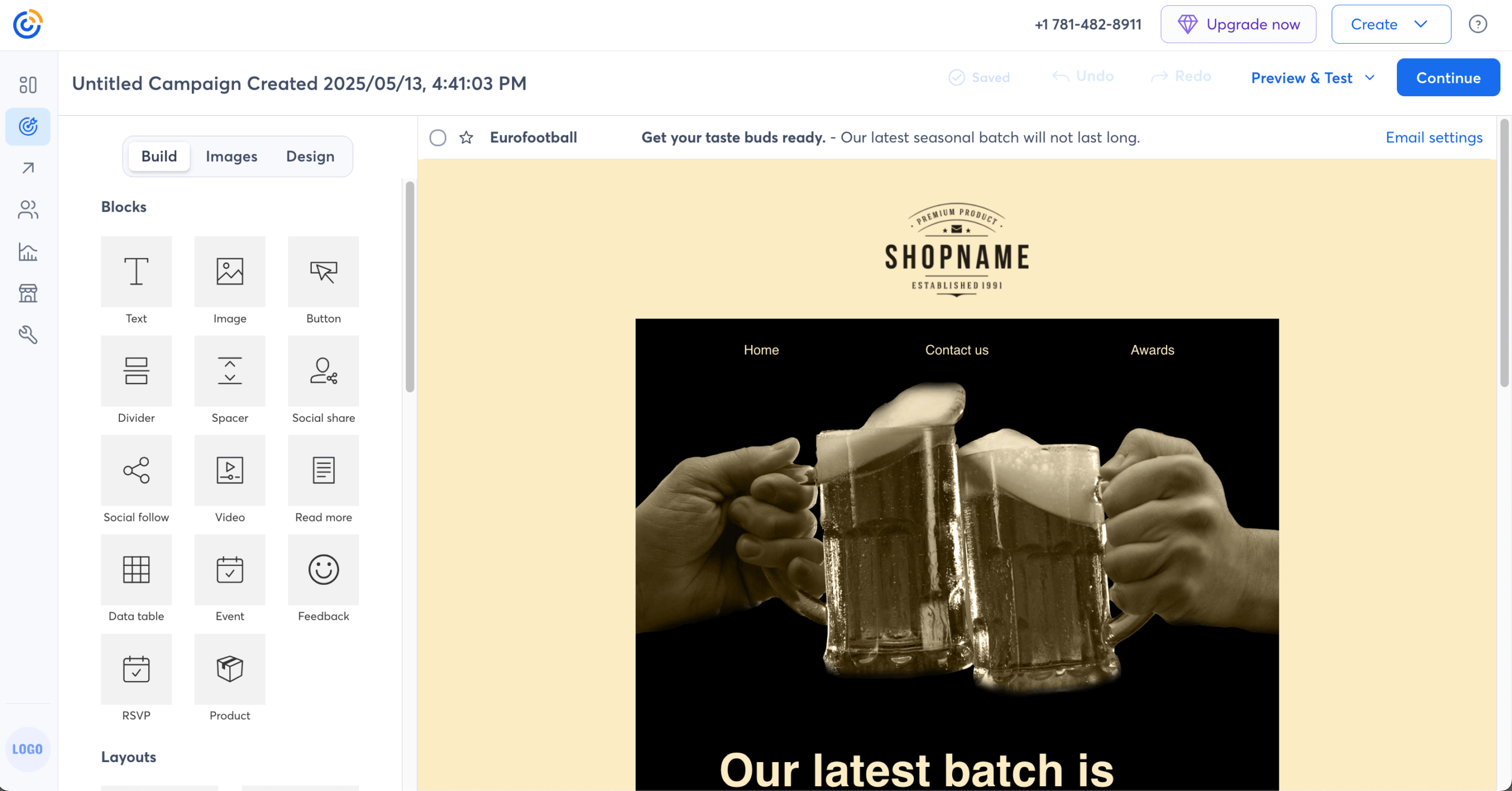
But here’s something I ran into—you can’t use A/B testing and the “resend to non-openers” feature together on the same campaign. It’s one or the other. Resends go out anywhere from 24 hours to 10 days later (you can also manually trigger them sooner).
The platform includes dynamic content insertion, so you can personalize emails based on subscriber data without creating multiple versions. The Heat Map reporting has become one of my favorite features. It shows you exactly where people clicked in your email with a visual overlay. Makes it easy to see if that button placement is working or if everyone’s ignoring your main call-to-action.
Constant Contact’s templates are functional rather than fancy. You’re working with their intuitive email editor which includes these specialized blocks for RSVPs, donations, and feedback forms. Pretty handy for adding interactive elements without coding anything.
From a quality standpoint, email templates are clean and reliable but not highly customizable—at least not when compared to alternatives like Sender. The overall designs lean toward safe, conventional layouts, rather than modern, brand-flexible visuals. But there’s 200+ mobile-ready templates to choose from, so there’s that at least.
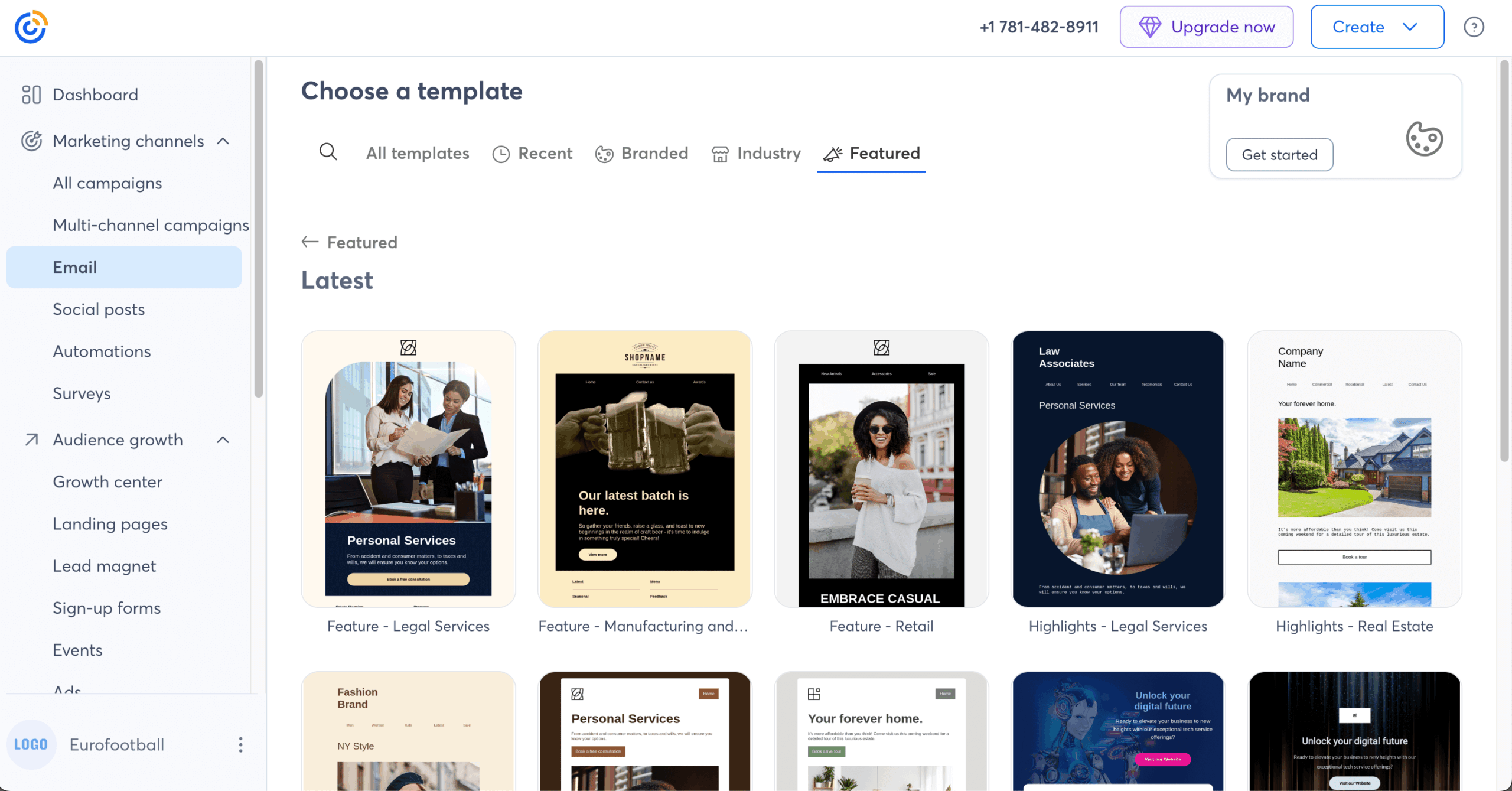
One feature that stood out to me is Constant Contact’s built-in link tracking for SMS. Whenever you send a text with a URL, the platform automatically shortens it and tracks who clicks. In practice, this makes SMS feel a lot less “blind.” You can instantly see which messages actually drive action, which subscribers engage consistently, and whether your timing or offers are landing.
The Text-to-Join feature, meanwhile, lets people opt in by texting your number. Of course, they have to reply “Yes” to confirm—no shortcuts around compliance here. There’s an AI helper for writing texts as part of the SMS marketing features, but honestly—with SMS, you’re dealing with so many regulations that you’ll spend more time on compliance than creativity.
Their SMS marketing add-on has serious restrictions you need to know about. The biggest caveat of Constant Contact’s SMS marketing feature is that it only works in the U.S. (no Puerto Rico or Virgin Islands either), and you’ll need a TIN (Tax ID) or EIN (Employer Identification Number) to register.
Constant Contact assigns you a dedicated number, and there are strict rules about sending times and content. If you need international SMS capabilities, Sender offers global reach without these geographic limitations.
The Automation Path Builder is where Constant Contact platform tries to be modern. I’ve played around with their pre-built automation templates for different ecommerce platforms (Shopify, Wix, Squarespace, WooCommerce) and found you can build decent customer journeys with delays, based on behavior, and SMS steps mixed in. Though, there’s still work to be done in terms of branching pathways.
Constant Contact for ecommerce works fine for most small business needs, though advanced automation isn’t really its strong suit. For more modern automation at a better price point, I’d recommend checking out Sender instead.
They’ve also got this separate Lead Gen & CRM system for handling more complex permission flows and double opt-ins. The Constant Contact CRM integration is useful when you need to prove someone gave consent. Most teams I’ve seen use the Path Builder for the actual messaging and the CRM side for managing permissions and tracking leads as their contact management system.
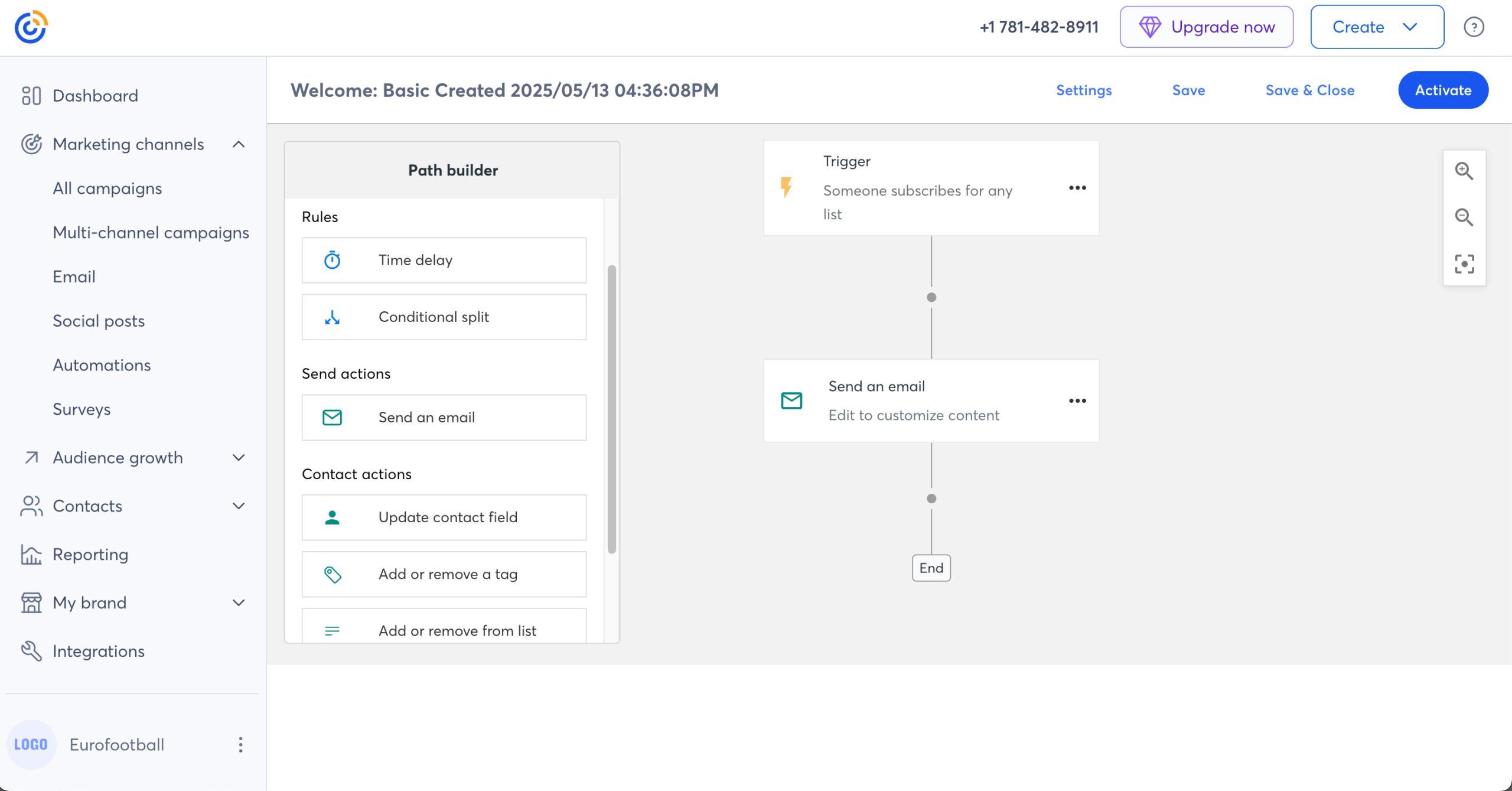
Constant Contact’s automation feels pretty limited once you move past the basics. You can set up welcome emails or simple date-based sequences, but that’s about it—no branching paths, no advanced triggers, nothing behavior-driven.
I found the segmentation inside automations to also be restrictive, while reporting isn’t deep enough to optimize anything meaningful. It works for beginners, but if you want real automation logic, you’ll hit the ceiling fast.
You get different form types—inline forms, pop-up, flyout, event registration forms, you name it—each one customizable for capturing different contact fields. The Sign-up Landing Pages work well for collecting both email and SMS permissions, and they feed right into your welcome sequences.
If you’re in a regulated industry or just want to be extra careful, you can set up double opt-in confirmation. Basically, you’ve got options from simple email capture all the way to fully verified contacts with documented consent.
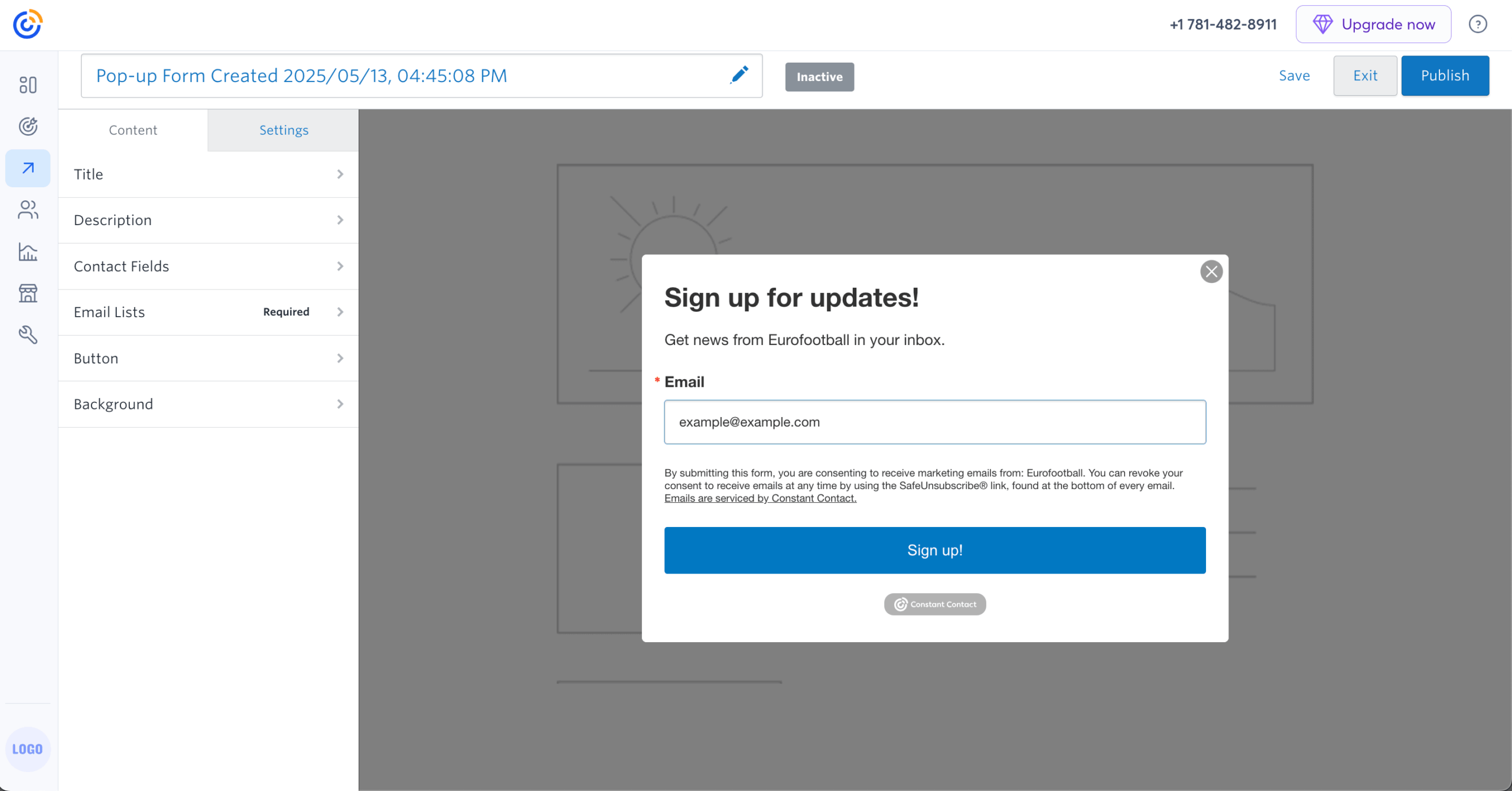
Constant Contact’s sign-up forms get the job done but feel pretty limited. Customization is minimal, layouts feel dated, and there’s no CAPTCHA to block spam signups. You can’t A/B test forms, you can’t reorder fields, and there aren’t built-in GDPR consent fields. Even the WordPress plugin feels bare-bones.
Their sign-up forms work for simple list building, I will give them that. But if you want polished, brand-tight forms or anything more advanced? You’re out of luck.
This confused me at first because there are two different systems. In the main Email & Digital Marketing area, you get Custom Landing Pages for promotions (which can use your own domain) and Sign-up Landing Pages for growing your list. Then there’s this whole other world in the Lead Gen & CRM section where you can build multi-page funnels using their website builder capabilities.
Another thing to note: landing pages can only use a single connected domain, and you can’t assign unique domains or subdomains to different pages. If you’re running multiple brands or segmented campaigns, that limitation becomes noticeable pretty fast.
Quick tip: if you’re selling digital products through their Shoppable Landing Pages, you have to manually mark orders as completed before delivering anything. Miss that step and things get messy fast. Pick your landing page type based on what you’re trying to do—simple sign-ups don’t need the complex funnel builder.
The “action blocks” are pretty clever. RSVPs get you quick yes/no responses right in the email (though it’s just for basic headcounts). The Feedback block handles ratings and polls with a thank-you page after. There’s a Donation block for nonprofits too.
One thing that tripped me up: RSVPs are super basic—just click tracking, really. You can’t enforce single choices or add any logic. If you need anything fancier, use their Surveys or Events features instead. Small distinction but it matters when you’re planning how to collect responses.
The Feedback block does star ratings and simple polls, showing a success page after someone clicks. You can create more detailed surveys with branching logic, though these live on separate survey pages rather than in the email itself. Event RSVPs get tracked in your Email Details report, but don’t expect much—it’s intentionally simple.
Now, about video embeds—this is where things get a bit limited. You can’t embed videos directly in emails (most email clients don’t support this anyway), but you can add video thumbnail images that link out to your content. For anything more complex than basic polls, you’ll want Survey Pages. They’ve got their own analytics and export options.
But watch out—once a survey is live, you can’t change much about its structure. You can tweak the text and answer options if the editor lets you, but the bones of it are locked. Learned that one the hard way during a campaign.
The Events 2.0 update is genuinely good for managing events and promoting them too. You can sell tickets, add-ons, use promo codes (including hidden tickets that only show with certain codes), and handle payment processing through Stripe with Apple Pay, Google Pay, and Link support.
Of course, no good things can come without any caveats. In this case, it’s the event management fee. For every ticket that you sell, Constant Contact’s cut is 5.4% + $0.80/transaction. It’s not greedy but it’s still worth considering.
The ticket sales system is more robust than I expected, however. You can set early bird pricing, create different ticket tiers, and manage capacity limits. Private events with access codes? Check. Event landing pages from templates? Check.
The checkout process feels modern with the cart and code redemption up front. All your reports and attendee management live in one dashboard. For workshops, fundraisers, or classes, it’s solid enough that you won’t need to cobble together three different tools.
Beyond the standard opens and clicks, you get decent campaign tracking that helps you understand performance over time. The overview reports and Heat Maps really help you understand what’s working—they show exactly where people are clicking with a visual overlay and track contact activity patterns.
Meanwhile, the revenue tracking functionality is available if you’ve connected your ecommerce platform or are using their event tools. Though it’s not as sophisticated as dedicated ecommerce email platforms. You can see which campaigns drive sales, but don’t expect deep attribution modeling. The platform also helps with spam testing, particularly—helping with spam reports to protect your sender reputation.
You can also enable bot-click filtering (still in beta, though) to prevent false link-clicks—such as those made by email-security software or scanners—from being counted in your reports. Once enabled, those suspected bot clicks are excluded from your “click rate” and automation triggers.
It’s a relatively new and slick feature that not every Constant Contact alternative has implemented—or did but placed it for Premium users only (looking at you, ActiveCampaign).
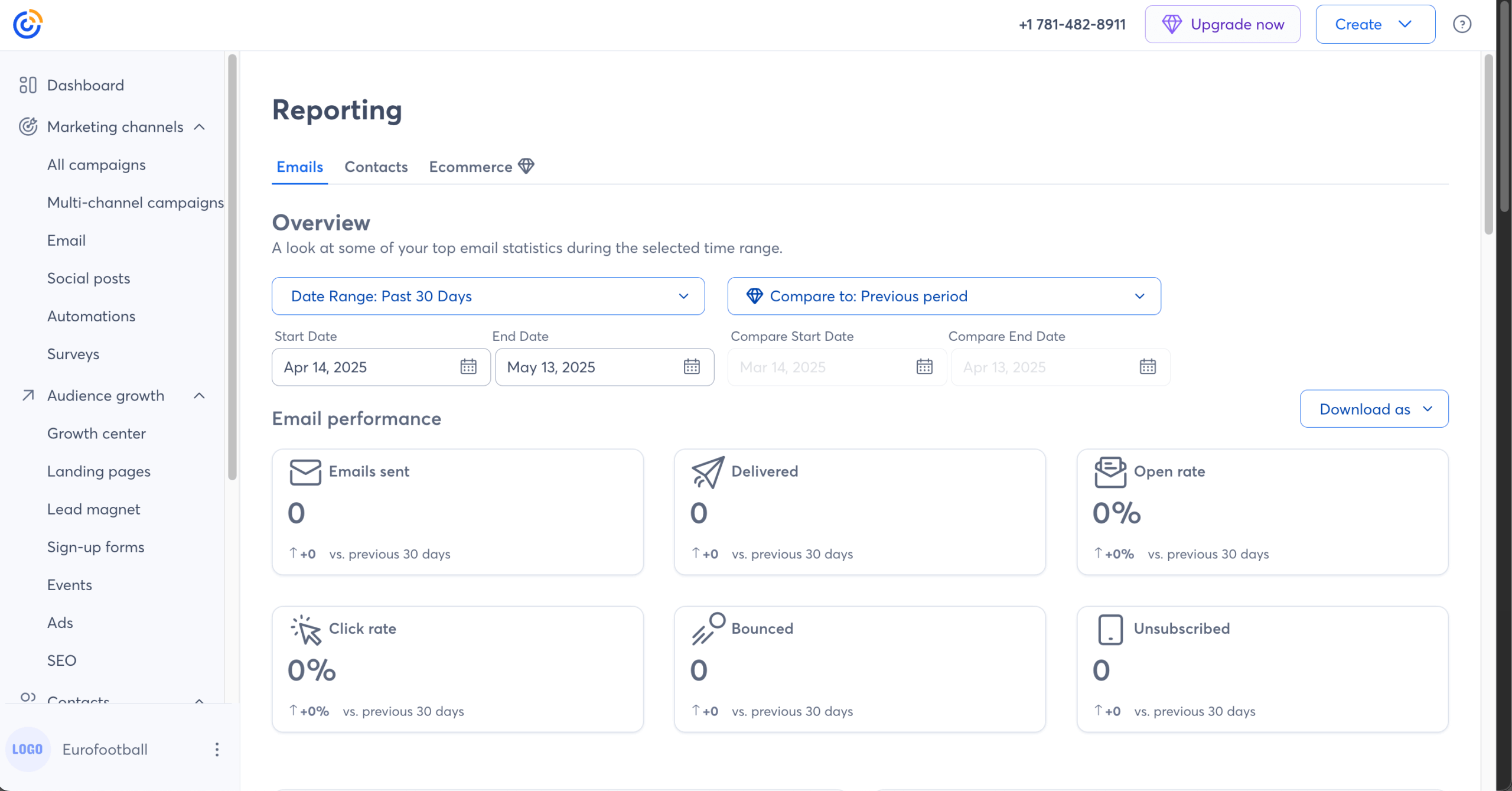
When it comes to deliverability, I was pleasantly surprised. My campaigns consistently landed in inboxes, and their 91.7% deliverability score from independent tests lines up with what I saw.
I noticed fewer random spam-folder drops compared to some cheaper tools, and my warm lists performed reliably across Gmail and Outlook. Of course, you still need clean lists and decent content, but Constant Contact gives you a solid deliverability baseline to work from.
The platform tracks where each contact came from pretty thoroughly—whether they signed up through a donation form, claimed a coupon, or bought something from a landing page. This granular tracking of contact details helps when you’re building segments or trying to figure out what’s driving growth.
The ecommerce integrations (Shopify, WooCommerce) automatically segment customers based on what they do. You can layer on engagement segments for VIPs or win-back campaigns. Your lists end up showing both actions and sources, which comes in handy for lifecycle campaigns or when you want to exclude certain groups from specific offers.
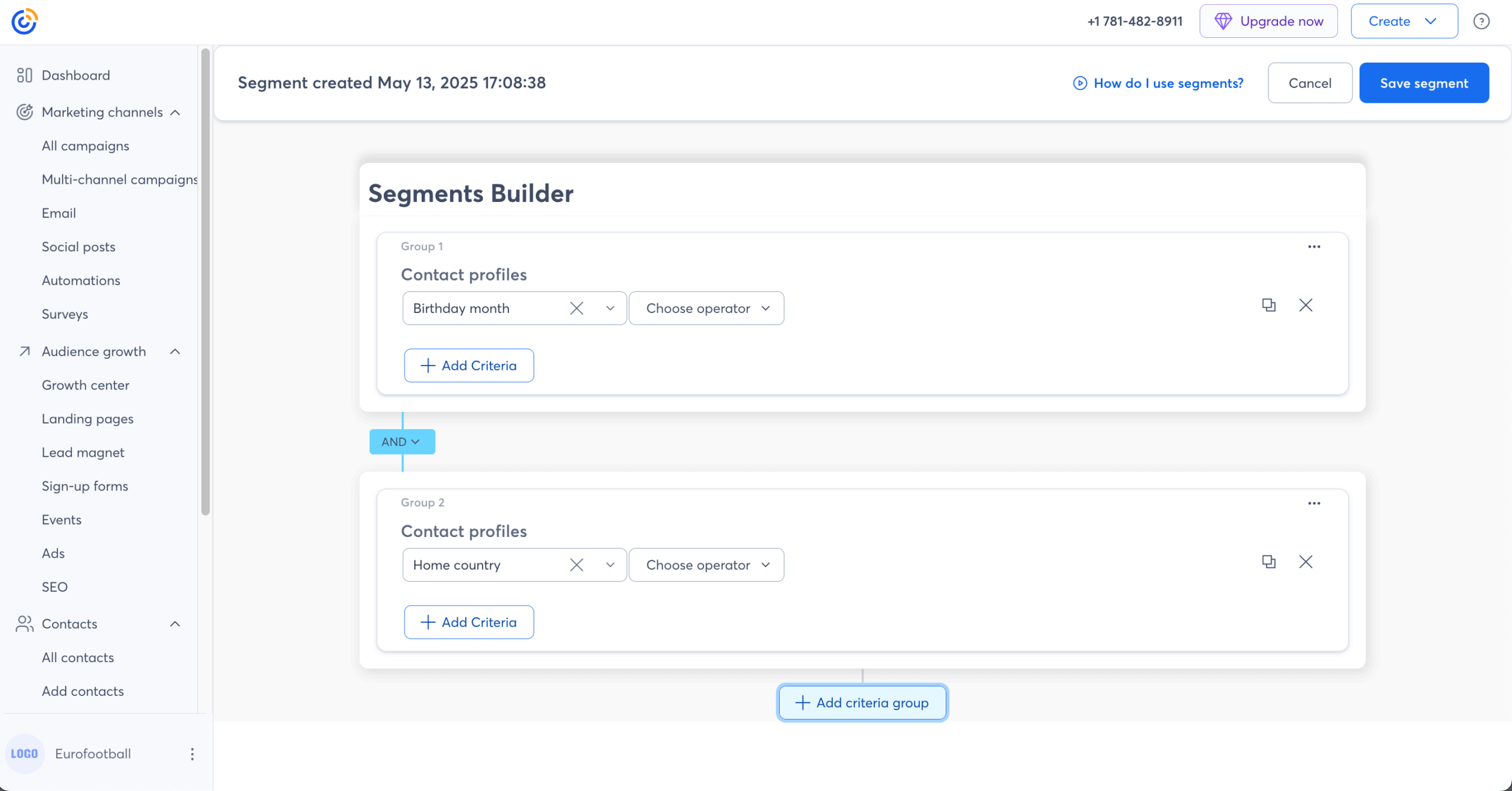
There’s a lot to like about Constant Contact’s pre-built engagement segments. For starters, they make it easy to quickly separate my most active subscribers from the ones who barely interact. It feels convenient when I just want to send a targeted message without setting up complex rules.
That said, the segments aren’t perfect—I’ve noticed they sometimes scoop up old or low-quality contacts, which makes the “least engaged” bucket a bit messy. And since deeper segmentation is locked behind higher-tier plans, I sometimes feel limited when I want more precise targeting.
You can run Facebook and Instagram ads right from the platform through their social media integrations, which I tested with mixed feelings about the results. Lead Ads dump sign-ups straight into your Constant Contact lists, and you can create Lookalike Audiences from your existing contacts to reach new people similar to your best customers. What Constant Contact offers here is decent for basic social campaigns.
Connecting your social media accounts lets you post, share emails and events as social media posts, check basic stats with social tracking, and reply to comments without switching tabs. It won’t replace a dedicated ad manager, but for basic list building and getting your content out there, it does the job.
The integration list surprised me—it’s bigger than expected with solid third-party integrations. Shopify and WooCommerce sync daily and segment customers automatically. The WooCommerce plugin even adds a product block for dragging items into emails. Stripe handles customer syncing and runs the event checkout.
For paid ads, the Meta Lead Ads integration pipes leads right into your lists. They claim thousands of integrations for common business tools. Bottom line: you can piece together a decent marketing setup—store, payments, ads, email—without custom development.
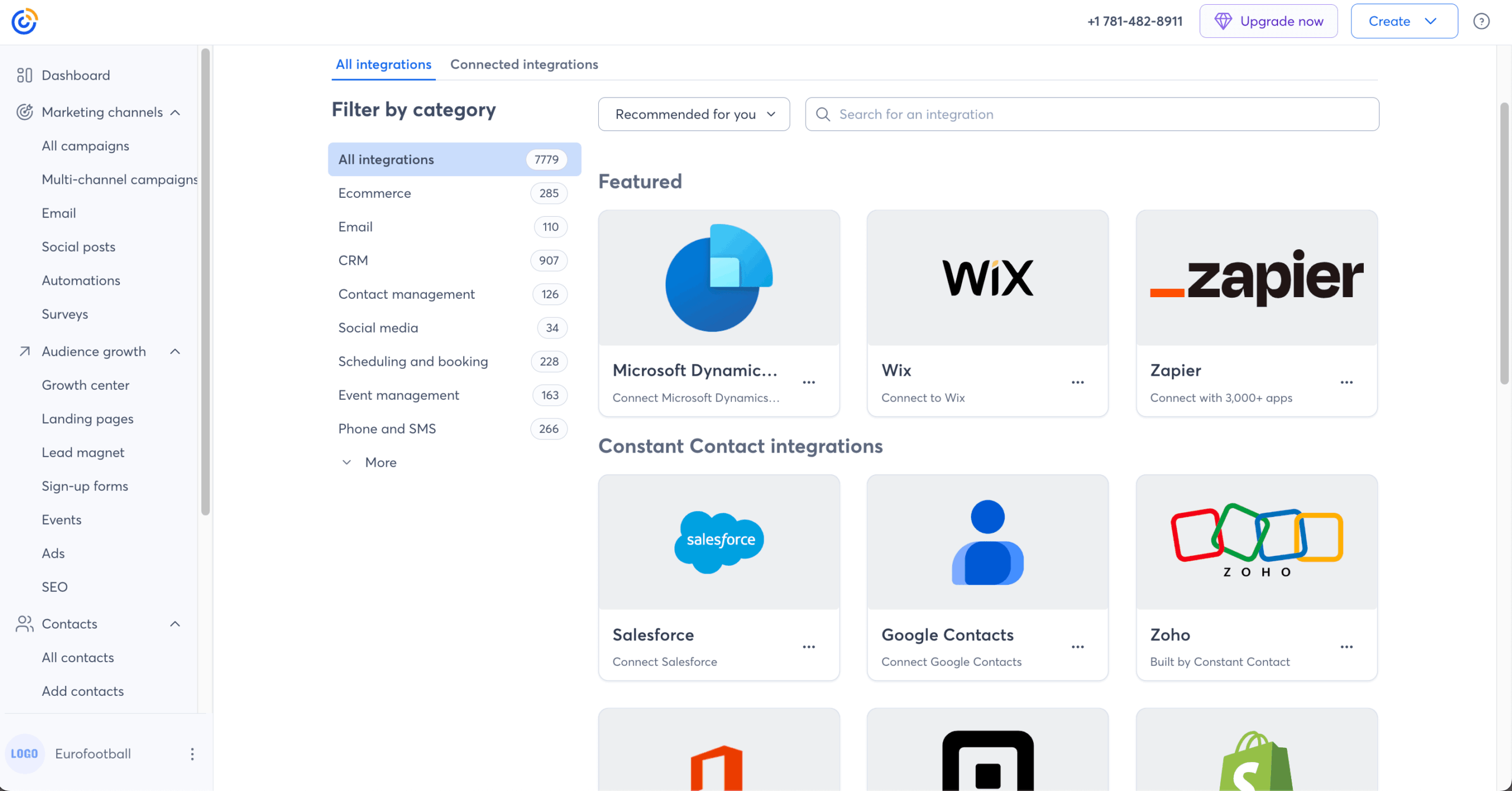
I’ve tested most of their support channels and training resources. There’s chat support and phone support Monday through Friday during business hours (08:00 am-08:00 pm) Eastern time, while on Saturday, it’s 10:00 am until 06:00 pm.
Additionally, there’s a thorough Knowledge Base, community-based support, and these “Ask-a-Trainer” sessions that run weekdays from 10:00 am to 04:00 pm Eastern. They also have a mobile app for managing campaigns on the go, though it’s pretty basic. If you need help outside regular hours, email support is available too.
Different departments have different hours, so check your Constant Contact account settings and the Help Center page before planning to tackle something big.
Chat and phone are better when something’s broken and you need help now. If you’re getting a team up to speed, set up some templates first, then hop on a trainer session to make sure everyone’s doing things the same way.
Free Trial
Lite
Standard
Premium
$0 14-day trial
$12/month (starting price)
$35/month (starting price)
$80/month (starting price)
If you’re a nonprofit, you can snag a pretty good deal with Constant Contact pricing: 20% off if you prepay for 6 months, or 30% off if you go for 12 months. To get the discount, you just need to show proof you’re a legit nonprofit (like a 501(c)(3) or equivalent), and they’ll also help sort out sales-tax exemption if that applies.
After spending real time with the platform and looking at key features in this Constant Contact review, I can confirm it’s genuinely easy to use—no technical knowledge needed. Email deliverability rates have been consistently solid in my tests, keeping messages out of the spam folder.
The customer support is refreshing; I’ve gotten through to real people on the phone even with basic paid plans, and those training sessions help more than you’d expect. Features like timezone scheduling and the visual heat maps made optimizing my campaigns way simpler than it should be. It plays nicely with the tools I already use—Shopify and QuickBooks.
The event management surprised me by handling everything from selling tickets to tracking attendees smoothly. If you’re a small business or nonprofit that wants professional marketing without the headache, this fits the bill. Many small business owners find this competitive advantage worth the cost. So is Constant Contact worth it? For the right audience, absolutely.
The email automation feels dated compared to what else is out there—no dynamic lists or complex workflows like other email marketing tools provide. After your 14-day trial, you’re paying whether you like it or not, and canceling isn’t quick either since you actually have to call to cancel your Constant Contact subscription (although it seems like you can do that now via customer support chat as well). Templates look fine at first, but customizing them beyond the basics means diving into HTML.
The segmentation is weirdly basic. I kept looking for targeting options that just weren’t there compared to modern platforms. Even worse, your contact tier doesn’t go down when you delete contacts, which feels pretty frustrating. And since there’s no unlimited contacts option, you end up paying based on your highest list size.
Meanwhile, API limitations have killed a few integration ideas I had, and the lack of design testing tools is another headache. Forms don’t offer CAPTCHA or GDPR-style consent fields, and personalization options stay limited unless you’re on a higher-tier plan.
Prices jump up fast when your needs grow, catching people off guard. SMS only works in the U.S., which is a dealbreaker for international businesses. Plus, there are no dedicated IPs or warm-up guidance if you want more serious deliverability control. The learning curve is minimal, but that’s mostly because the Constant Contact features are limited. If you’re used to modern email marketing tools, this one feels restrictive.
Perfect For
Not Great For
Local businesses and nonprofits needing event promotion and community engagement tools
Ecommerce businesses requiring sophisticated product automations and sales funnels
Independent service providers and consultants who value simplicity and support
Tech-savvy marketing teams looking for advanced custom workflows and deep integrations
Organizations centered around events with Eventbrite integration needs
Data-driven marketers who require predictive analytics and detailed attribution models
I’d say it works best for small to mid-sized businesses, nonprofits, and local organizations that need an all-in-one solution without the complexity. Specifically, Constant Contact for small business makes sense when teams care more about ease of use than fancy features—they’ll appreciate the built-in engagement tools for RSVPs, surveys, and donations, plus the event marketing capabilities. What Constant Contact offers makes sense for specific audiences who prioritize simplicity.
Constant Contact for nonprofits particularly shines—they seem to like it for fundraising campaigns and keeping volunteers in the loop with donation blocks and event tools. But for a reliable SMB workhorse, Constant Contact makes it easy to use. It does what it says on the tin.
If you’re running enterprise-level email marketing with multiple brands, international teams, non-U.S. customers, or need serious deliverability expertise, this Constant Contact review found that the platform won’t cut it.
High-volume senders looking for AI-driven segmentation, predictive analytics, or advanced optimization should check out ActiveCampaign, Klaviyo, or HubSpot instead. For most of these users, I’d specifically recommend Sender as a more modern, cost-effective solution.
If your operation runs through big CRMs like Salesforce or Dynamics and needs deep two-way syncing, custom objects, or complex APIs, you’ll want something else. And if you’re the type who needs total control over email code and pixel-perfect designs, Constant Contact will drive you crazy with its limitations.
Looking at Constant Contact customer reviews on G2, the platform’s ease of use, intuitive drag-and-drop builder, and time-saving automation emerge as major strengths—making it popular with small businesses and nonprofits. Users praise how quickly they can launch professional campaigns, track engagement, and stay connected with donors or customers.
However, reviewers consistently note limitations: the SMS system is restrictive, the reporting could be more customizable, and the email editor sometimes feels clunky—especially for those wanting pixel-perfect templates or embedded video control. Overall, the Constant Contact ratings value simplicity, but it’s not always flexible enough for advanced users.
Capterra’s Constant Contact testimonials praise the platform for its ease of use, helpful customer support, and versatile tools like landing pages and website builder, which make it a strong all-in-one solution for small businesses. Users appreciate how quickly they can create campaigns and manage communications in one place.
However, some negative reviews flag clunky formatting, unsophisticated contact management, and platform quirks like settings not always saving. Event management features were specifically cited as lacking depth for professional event teams, prompting some users to switch to competitors with more robust capabilities.
Reddit reviews of Constant Contact show a mix of appreciation and frustration. Positive users praise its ease of use, beginner-friendly templates, and strong customer support that “holds your hand” through setup. Some even rate it higher than competitors like Mailchimp and ActiveCampaign for its guidance and simplicity.
On the flip side, negative Constant Contact user feedback highlights platform glitches (like edits reverting), inconsistent experience with support reps, and a feeling that the service can be clunky for power users. Overall, Reddit’s verdict leans positive for beginners but warns experienced marketers to expect some workflow friction.
Constant Contact vs. Mailchimp
I’ve used both extensively, Constant Contact vs. Mailchimp, and here’s the deal with this Constant Contact review comparison: Constant Contact is easier to pick up and start using. The interface makes more sense, and you can get campaigns out faster with what Constant Contact offers.
Mailchimp gives you more to work with though—better automation, deeper testing options, fancier list management, and those AI design features everyone’s talking about. Plus Mailchimp has a free plan, while Constant Contact just gives you that trial.
If you need to send nice-looking emails without the fuss, go with Constant Contact. But if you’re trying to grow aggressively with complex automations and ecommerce integrations, Mailchimp’s probably your better bet.
Constant Contact vs. HubSpot
When comparing Constant Contact vs. HubSpot, I’ve noticed that the first one is way easier to get started with—importing contacts takes minutes, setup is straightforward, and there’s less to learn.
HubSpot is a different beast entirely. It’s a full CRM plus marketing platform with lead scoring, behavior tracking, and separate hubs for sales, marketing, and service. Everything feeds into this central system that’s admittedly complex but incredibly thorough.
Small teams and nonprofits that need email and event tools will find Constant Contact more manageable. But if you need a proper CRM with cross-team workflows and sophisticated segmentation, HubSpot makes more sense despite the learning curve.
Constant Contact vs. ActiveCampaign
Finally, Constant Contact vs. ActiveCampaign… The latter is built for marketers who want control—complex automations with branching logic, full CRM features, tracking across multiple channels. Constant Contact keeps things simple, focusing on usability and getting campaigns out quickly with decent event tools thrown in.
The trade-off is clear: ActiveCampaign’s advanced features mean a steeper learning curve and higher prices. For businesses with complex sales funnels or serious ecommerce needs, it’s worth it. But if you just need something dependable and easy that your whole team can use without training, Constant Contact still has its place.
If you want advanced automation, deep ecommerce features, or a modern interface, ActiveCampaign, Klaviyo, or HubSpot will serve you better than Constant Contact ever would.
That said, another superior Constant Contact alternative—especially for general users who’re looking for the all-inclusive package—is Sender. It gets you 2,500 subscribers and 15,000 emails monthly for free, plus drag-and-drop email and SMS workflows, templates, popups, landing pages, and decent integrations.
Yes, Constant Contact is outdated in a way. The template library could use some new designs, and the design tools aren’t as slick as what newer email marketing software offers. The automation logic is pretty basic, and the interface could use a fresh layer of paint.
Email marketing services like Sender and Kit are showing what modern email marketing looks like though. Better editors, generous free plans, transparent pricing, and faster feature releases.
Constant Contact’s monthly email sending limits depend on your plan. The Lite plan allows up to 10× email sends based on your chosen contact limit. While Standard is 12× and Premium is 24×. Each email sent to each contact counts toward this limit. Exceeding it adds small overage fees, though automated emails don’t count toward your monthly allowance.
In order to cancel your Constant Contact subscription, you have to call their customer support team. Here you can find the contact information based on your country of residence. An alternative solution is not to touch your Constant Contact account for 120 days, after which it will be deleted automatically.
